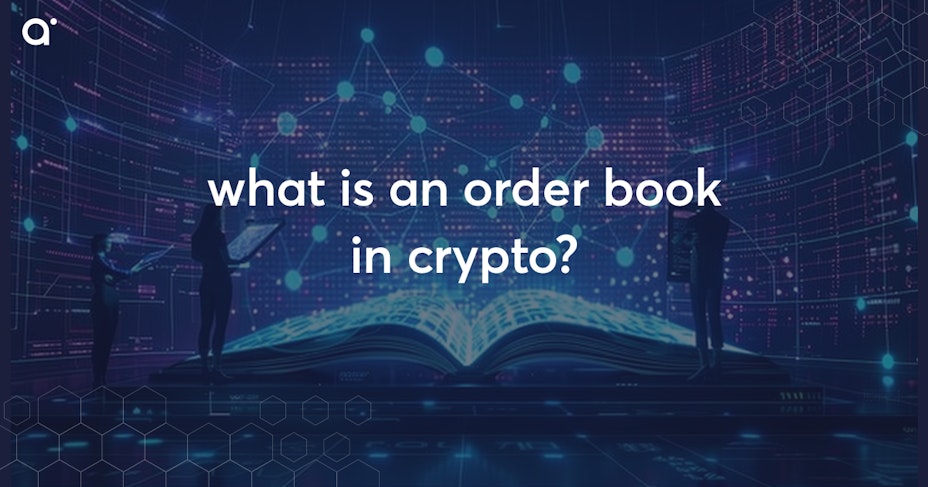How does an order book crypto work
- 15 minute read

An order book shows all open orders from buyers and sellers of a cryptocurrency and in what volumes. So you can quickly see if there is a lot of liquidity in the coin you are interested in, as well as whether volumes are getting in the way due to buy or sell walls.
In this article, we will take a closer look at the order book so that you will be prepared when you start working with it.

- The order book was adopted from stock trading and is now fully digital
- Volumes in an order book indicate support and resistance and liquidity, which is essential for day traders
- With an aggregated order book you get an overview of liquidity on all exchanges combined, this can be especially useful with Bitcoin, the market leader and market maker
- The processed order book is in the candlesticks, with a green indicating more buying and the price rising and a red the opposite
- Never use rounded bid or ask quotes, as you will join the back of the line of a buy or sell wall
- If you do technical analysis first and then go into the order book to see where you want to enter, that's a great plan
- In an order book you can usually use a limit order, stop loss, market order, iceberg order, take profit order, trailing stop order and for the big investors Over The Counter to bypass the order book and not affect the price
- On a DEX, the order book is often hidden and you have limited options when opening an order
- The order book is essential for day traders, for swing traders and other longer-term investors it is only of interest at 1 point in time
- Trading bots and market makers provide high liquidity
- Buy walls and sell walls are high volumes in the order book that must be processed before the price moves, rounded numbers are often "natural" barriers and also count as a wall
- Walls are often used by investors with many coins to manipulate the price to their own advantage
Inhoudsopgave
- What is an order book crypto?
- How do you work with an order book?
- An order book on a DEX
- The importance of an order book
- What are buy and sell walls
- Personal order book
- Conclusion
What is an order book crypto?
The order book was adopted from the stock market and works exactly the same way. An intermediary such as an exchange or broker brings supply and demand together. Traders actually buy and sell from each other through the order book. Fortunately, we no longer have to shout at an exchange like Wall Street and make it clear with hand gestures that we want to buy or sell. We sit relaxed behind a computer screen.
Digital order book
An order book today is a digital record of how many investors want to buy a financial product and at what prices. Order books are also used to track the price of a cryptocurrency in an organic way, using the current price on all exchanges to determine the average price and listing it on CoinGecko, for example. There are several variants of an order book.
Volume order book

In a volume order book (depth chart) you can see the spread, a list of all bid (green buy orders) and ask (red sell orders) prices, grouped into price ranges. This allows you to see at a glance if there is more demand than supply, as one of the two displays high volumes closer to the current price. This can be useful for knowing whether the price is more or less likely to rise or fall. Especially day traders can benefit from this.
Price order book
You can also see in a price order book what exact prices a cryptocurrency will go over the counter at a fluctuating price and in what volumes. If there are huge volumes of buy orders and sell orders around the current price then chances are that this cryptocurrency will move sideways. If you see that there is hardly any supply and a lot of demand, then the chances of the price going up are very high. Moreover, you can see there which rates are popular, such as rounded prices, so you can choose a rate that has little competition on it.
Depth in an order book
In an order book with supply and demand and the prices associated with it, you can also see what impact trading is going to have. If there are many potential buyers for a crypto around the market price and in high volumes, the price will struggle to rise because of high liquidity . Especially the volumes determine the changes in price. If there are many bids in low volumes, the price is easily passed by and can continue to rise. If high volumes are offered, the same applies, but the price will fall less quickly. However, a trading book works in the very short term.
In an order book you can also see the liquidity of a crypto. If you see that supply and demand seamlessly match the current price and in sufficient volumes then it is a very liquid crypto. If you see that supply and demand are far apart and the current price is 1 euro and there are only orders at 0.75 and 1.25 in low volumes, then this coin is very illiquid. You can't even buy or sell it at the current market price yet. You see this more often with cryptocurrency with low market cap . Low liquidity may also increase transaction costs.
Aggregate order book
Another type of order book is an aggregated order book. In such an order book, you get an overview of supply and demand on multiple platforms simultaneously. Usually you need to download a special app for this. Especially for important cryptocurrencies like Bitcoin, this allows you to look much deeper into supply and demand and see which side has more weight: supply or demand. This can be very useful for traders with a limited trade horizon, such as day traders with a horizon of minutes to hours. Based on this, you can also determine a buying moment for altcoins , because Bitcoin is the market leader and sets the direction of the market.
Candlestick chart
You can see the processed order book in a candlestick chart. There you can see how much volume has been processed per day and whether the price has risen or fallen. If more has been sold than bought there will be a red candlestick and a green one if more has been bought. The daily chart is the most commonly used, so you can zoom out a bit to determine the trend. Again, if you are a day trader you use a much shorter time frame, usually in minutes to 15 minutes.
Trading in pairs
It is also possible to sell cryptocurrency for another cryptocurrency. This is only recommended if you are working with very popular coins, otherwise liquidity is often so low that sometimes your order may not be executed at all. Also, one of the two coins can make weird jumps in the pair, causing the ratio to grow so lopsided that your order gets further and further out of whack. The best reason to take advantage of it anyway is that you will only have to pay fees for exchanging once.
How do you work with an order book?
It's usually not a good idea to buy a cryptocurrency at exactly 1, 2 or 3 euros. This is something a lot of people do, which means you have to join behind all these traders before it's your turn. It may well happen that some of these traders buy their coins, after which the price rises again, leaving you behind the net. Better to bid 1.01 or 1.001 if you can. That way you pay a little more, but are ahead of the "lazy" traders.
The reverse also applies, of course. If you want to sell crypto you put a sell order at a rate of 0.99 or 0.999 and not at 1. The same logic applies when selling as well. It's just a shame if you are just too late to sell or buy your coins and things get out of hand and you can't get your coins sold or you have to buy them at a much higher rate.
Technical analysis in crypto
While order books provide traders with important information about current potential price movements and are useful to place your trade, they are too limited to base your investment timing on. If you want to buy or sell a cryptocurrency, it is useful to first have a technical analysis do using indicators, such as Bollinger Bands or Moving Average, to determine momentum and market trend. Only then do you go into the order book to see where you want to place a trade based on a gap in the order book.
Limit orders
When you go to place an order in the order book, you have a number of options. By far the most commonly used order is the limit order, where you enter a specific price at which you want to buy the cryptocurrency. With a limit order, you limit the buy or sell price to the only one you are willing to take action for. If you specify slippage yet, you plan to buy a coin at a certain price with a small percentage extra, in case your order can only be partially filled.
Stop loss orders
There are a number of additional options nowadays at many exchanges and brokers to put a trade in the order book. For example, an important action is to set a stop loss. Suppose you bought a coin for 0.999 and you want to limit the maximum loss, you can set a stop loss, so that if the price unexpectedly drops to, say, 0.901 the stop loss is triggered and you can only lose around 10% on your investment. Especially in times of bear markets, this is an essential strategy, as prices can fall hard then. Of course, buying crypto in a bear market is usually not practical, but the transition from bull to bear market can never be accurately predicted.
Market order
What some traders do is buy a crypto at the market price. This is never a good idea. It is similar to standing in a marketplace and shouting that you will buy something at any price. That's going to cost you money! If you buy at the market price, you are buying not only for the current price, but also for every higher price until your order is completely filled. That can cost a lot of extra money. The same goes, of course, for selling at the market price. That can yield much less.
Take profit, iceberg, trailing stop orders

There are other tools found on many exchanges. They you can set take profit to take profits, so you don't let profits evaporate due to greed or hope. You also have iceberg and trailing stop, with luck. Iceberg is used to place large orders in pieces in a hidden order, so there is less market impact on the price. In the order book you then see, for example, 1/15th of the total visible orders and the rest are hidden orders. Sneaky, mind you!
A trailing stop order is used to limit losses but allow profits. If you buy a coin for 5 euros and set a trailing stop at 4.50, the coin will be sold when it drops to 4.50. However, if the coin rises to 10 euros and then falls to 9.50 it is only sold. Trailing thus gives a precise amount in fiat money or stablecoins to that needed in terms of rise or fall, after which the coin is sold.
Over The Counter

One way to avoid the order book altogether are Over The Counter (OTC) orders. Here you buy a particular cryptocurrency from the exchange or from market makers without ever placing the order in the market. This often happens with very large orders, such as when one exchange buys from another or with institutional investors and large investment funds like BlackRock and Grayscale.
Some platforms have no order book at all and work with direct trading (peer to peer), but this is an ineffective way when it comes to liquidity and costs.
An order book on a DEX
There are also exchanges where none of this is possible, such as a DEX (decentralized exchange). So if you can't set a limit price or stop loss, you will have to be present on the exchange when the price of the cryptocurrency you have your eye on is exactly where you want it to be. This is obviously not convenient in a volatile market like cryptocurrency. Tomorrow everything could be different and your coins are worth nothing or that coin has exploded and you have to pay much more for it.
Mempool DEX
Another aspect is that you usually cannot see which orders are all open. A DEX uses a mempool, which keeps track of all orders that are open. To view this mempool, you really have to go look it up. This is rather cumbersome. On a DEX you also have to deal with front running by bots .
Front running

If you trade on a DEX, you must not only type in a price at which you want to buy the token, but also how much gas fees and slippage you are willing to pay. A bot can see this and offer more gas fees, making its order executed sooner. Once he is pre-crawled (front running) he sells the tokens to you for your maximum slippage and pockets the profits. This does not happen on central exchanges because it is prohibited. On a DEX you just have to take many more things into account and pay many more types of fees.
Atomic swaps
You can also use atomic swaps in order to eliminate the middleman. Through a smart contract this way you can exchange peer to peer tokens at a pre-agreed rate. You thus bypass the order book and pay far fewer fees. It is a bit more technical, though.
The importance of an order book
An order book is very useful to quickly see what price a cryptocurrency is at, how high the liquidity is, what volumes are in supply and demand and how the price is more than likely to behave in the short term (hours to a day).
Day trading with an order book
Especially day traders can use this to determine their buying moment. For example, if you want to buy a crypto for 1 euro and you want to sell it for 1.03, but there is a lot of volume in the 1-1.03 range, it might not be the best time for such a day trade. The best time would be when the price is likely to rise (high demand), but that the volumes in supply are low, because then you will reach your target price faster.
Swing trading with candlestick charts
If you have a longer trading horizon, like in swing trading, the daily candlestick chart is a lot more convenient. With this chart you'll be able to see at a glance the trend of the market and where support and resistance are situated. In this way you can determine the buying moment, your stop loss (below the support) and the prices at which you are going to take profits (below the resistance).
Trading bots

An order book is also useful for trading bots and market makers. A trading bot can usually be set up to define a range and try to take profits in between. Using the order book, a trading bot can then, for example, buy a token with a range of 2% up and down. If the price is 1, then the bot buys for 0.98 and sells for 1.02. In order books, you see this trick a lot.
What are market makers?
Market makers also use the trading book this way. These are professional investors who look to see if there is more demand than supply. If there is more demand, they will buy a token for around the current price and want to make a small margin on it. This is very possible as there is more demand. For example, they will then buy a token for 25 euros and sell it again for 25.15. This is a very small margin though, but if you do it in high volumes and if they place non stop orders the profits can go up quite a bit. Usually these market makers also pay little to no trading fees, keeping it profitable.
Market makers can also be organizations that literally make the market, by providing liquidity for exchanges. They constantly keep buying at the asking price and selling at the offering price, thus not only providing liquidity but also making very small margins themselves on a constant basis, making market trading more fluid.
What are buy and sell walls

You come across them more often: the buy or sell walls or walls. They are called walls, because they appear to be a wall that you have to cross first in order to continue. In technical analysis these walls are often called support and resistance.
Sales wall or sell wall
A sell wall is a single or multiple order with very high volumes. If someone is planning to sell 1 million Bitcoins at a certain price, you can speak of a sell wall. After all, all those coins must first be sold before the price can continue to rise.
A logical consequence of a sell wall is that the price will fall. After all, there is enormous supply at a given price. Traders who want more for their Bitcoin are waiting endlessly until those 1 million have finally been sold. Often traders then choose to give up their money, fearing that the price will fall because of the wall, and by selling their Bitcoin for less than the wall, the price will actually fall.
Buy wall
The opposite happens with a buy wall. If the price of a cryptocurrency is overbid in high volumes, it is logical that the price will soon rise to this particular price and then other traders will bid higher following the same logic. Of course, you can start bidding less than the wall, but then all those coins from the buy wall will have to be bought up before it's your turn.
Cumulative walls you often see at rounded amounts like 1 euro, 10 euros, 100 euros. Therefore, it is also not a good idea to join that, as mentioned, and offer a little more or ask a little less.
What is a pump and dump scheme?
A wall can also be used by whales, who have huge amounts of coins of a particular crypto, with the goal of manipulating the price. Thus, he can push the price up through a buy wall or lower the price through a sell wall.
One way to use this trick is to use the pump and dump scheme , where he gradually buys more and more of a crypto without much price impact, then puts down a mega sell order. When the price has risen enough he dumps his entire bag and may buy it again later for a much lower price. This usually happens with coins with less market cap, because otherwise it costs too much to execute.
Protecting an investment with a wall
Another way to use a wall is to protect your investment. For example, if you went short (leveraged and collateralized betting on a falling price) on a cryptocurrency and your investment is about to be liquidated, you can set up a buy wall to prevent the price from rising so far that you lose a lot of money. With any luck, people will then start selling the coin and the price will drop, allowing you to quickly cut your losses or even make a profit. Of course, you can only do this if you have enough funds to carry it out.
Personal order book
If you put all the trades you make in an order book, you can occasionally study what you have done in the past. That way you can see which trades were successful and which ones caused you losses.
A personal order book or trading diary can help you become a better trader by learning from your mistakes and trying to repeat your successes.
Conclusion
Order books are an indispensable tool especially for day traders, because an order book reflects supply and demand and volumes. Making smart use of this can make their results a lot better.
Those who want to sell cryptocurrency on short notice can find a hole in an order book with little competition, so that if the price hits that high you will also lose the coins immediately.
Those with a somewhat longer time horizon can use the daily candlesticks to execute swing trades.
Those who understand the order book well will place their orders smarter, which can pay them quite a bit over time.


